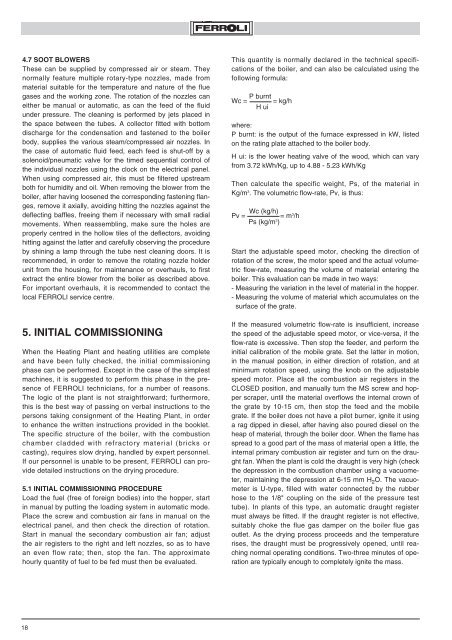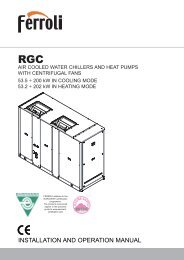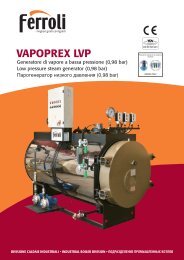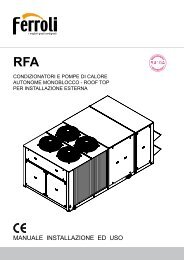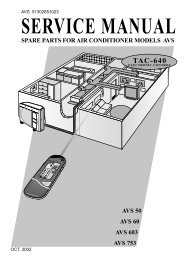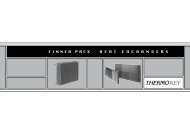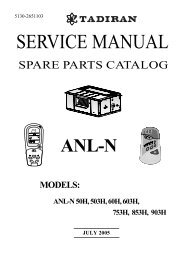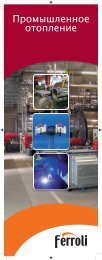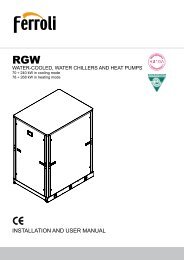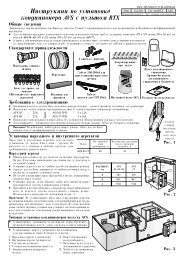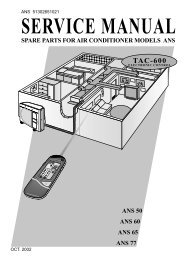4.7 SOOT BLOWERSThese can be supplied by compressed air or steam. Theynormally feature multiple rotary-type nozzles, made frommaterial suitable for the temperature and nature of the fluegases and the working zone. The rotation of the nozzles caneither be manual or automatic, as can the feed of the fluidunder pressure. The cleaning is performed by jets placed inthe space between the tubes. A collector fitted with bottomdischarge for the condensation and fastened to the boilerbody, supplies the various steam/compressed air nozzles. Inthe case of automatic fluid feed, each feed is shut-off by asolenoid/pneumatic valve for the timed sequential control ofthe individual nozzles using the clock on the electrical panel.When using compressed air, this must be filtered upstreamboth for humidity and oil. When removing the blower from theboiler, after having loosened the corresponding fastening flanges,remove it axially, avoiding hitting the nozzles against thedeflecting baffles, freeing them if necessary with small radialmovements. When reassembling, make sure the holes areproperly centred in the hollow tiles of the deflectors, avoidinghitting against the latter and carefully observing the procedureby shining a lamp through the tube nest cleaning doors. It isrecommended, in order to remove the rotating nozzle holderunit from the housing, for maintenance or overhauls, to firstextract the entire blower from the boiler as described above.For important overhauls, it is recommended to contact thelocal FERROLI service centre.5. INITIAL COMMISSIONINGWhen the Heating Plant and heating utilities are completeand have been fully checked, the initial commissioningphase can be performed. Except in the case of the simplestmachines, it is suggested to perform this phase in the presenceof FERROLI technicians, for a number of reasons.The logic of the plant is not straightforward; furthermore,this is the best way of passing on verbal instructions to thepersons taking consignment of the Heating Plant, in orderto enhance the written instructions provided in the booklet.The specific structure of the boiler, with the combustionchamber cladded with refractory material (bricks orcasting), requires slow drying, handled by expert personnel.If our personnel is unable to be present, FERROLI can providedetailed instructions on the drying procedure.5.1 INITIAL COMMISSIONING PROCEDURELoad the fuel (free of foreign bodies) into the hopper, startin manual by putting the loading system in automatic mode.Place the screw and combustion air fans in manual on theelectrical panel, and then check the direction of rotation.Start in manual the secondary combustion air fan; adjustthe air registers to the right and left nozzles, so as to havean even flow rate; then, stop the fan. The approximatehourly quantity of fuel to be fed must then be evaluated.This quantity is normally declared in the technical specificationsof the boiler, and can also be calculated using thefollowing formula:Wc = P burnt = kg/hH uiwhere:P burnt: is the output of the furnace expressed in kW, listedon the rating plate attached to the boiler body.H ui: is the lower heating valve of the wood, which can varyfrom 3.72 kWh/Kg, up to 4.88 - 5.23 kWh/KgThen calculate the specific weight, Ps, of the material inKg/m 3 . The volumetric flow-rate, Pv, is thus:Pv = Wc (kg/h) = m 3 /hPs (kg/m 3 )Start the adjustable speed motor, checking the direction ofrotation of the screw, the motor speed and the actual volumetricflow-rate, measuring the volume of material entering theboiler. This evaluation can be made in two ways:- Measuring the variation in the level of material in the hopper.- Measuring the volume of material which accumulates on thesurface of the grate.If the measured volumetric flow-rate is insufficient, increasethe speed of the adjustable speed motor, or vice-versa, if theflow-rate is excessive. Then stop the feeder, and perform theinitial calibration of the mobile grate. Set the latter in motion,in the manual position, in either direction of rotation, and atminimum rotation speed, using the knob on the adjustablespeed motor. Place all the combustion air registers in theCLOSED position, and manually turn the MS screw and hopperscraper, until the material overflows the internal crown ofthe grate by 10-15 cm, then stop the feed and the mobilegrate. If the boiler does not have a pilot burner, ignite it usinga rag dipped in diesel, after having also poured diesel on theheap of material, through the boiler door. When the flame hasspread to a good part of the mass of material open a little, theinternal primary combustion air register and turn on the draughtfan. When the plant is cold the draught is very high (checkthe depression in the combustion chamber using a vacuometer,maintaining the depression at 6-15 mm H 2 O. The vacuometeris U-type, filled with water connected by the rubberhose to the 1/8" coupling on the side of the pressure testtube). In plants of this type, an automatic draught registermust always be fitted. If the draught register is not effective,suitably choke the flue gas damper on the boiler flue gasoutlet. As the drying process proceeds and the temperaturerises, the draught must be progressively opened, until reachingnormal operating conditions. Two-three minutes of operationare typically enough to completely ignite the mass.18
Check this through the boiler door, opening it only very slightly,with care. At this point, manually set the screw, primarycombustion air fans and mobile grate in motion. Again adjustthe boiler outlet damper so that the depression in the combustionchamber is 5-6 mm H 2 O. After a certain period of operation,the temperature in the combustion chamber will rise.Slightly increase the opening of the primary combustion airdamper (A1), without however allowing the flame to becometoo violent and the fuel to be projected upwards. Rather, if thebed of fuel tends to rise and the flame is smoky, allow moreair to enter. At this point, open the primary combustion airdampers (A2 and A3), according to the consumption of thematerial deposited on the corresponding grate. If these areempty due to too-rapid combustion of the material being deposited,choke the dampers in question; vice-versa, if the materialtends to accumulate excessively, allow more air in. Whilststressing that this operation must in any case be co-ordinatedby expert personnel, the quantity of air can also be correctedaccording to the % of CO 2 in the flue gas, measured using suitableinstruments. At this point, it may be necessary to adjustthe speed of the mobile grate. This works optimally when it iscovered by material along its entire length. Too slow speedskeep the material heaped at the top, leaving the final gratesempty and thus feeding false air. On the other hand, excessivespeeds spread the material better, yet discharge unburntmaterial into the ash dump. Careful observation in this sense,through the front door, allows the correct speed to be set forthe type of material used. Turn on the secondary combustionair fan, remembering that at this point, the boiler outlet dampermust be re-calibrated so as to reset the depression in combustionchamber. Finally, adjust the secondary combustion airdampers. The quantity of this air also depends on the type offuel, and should be adjusted so as to minimise the amount ofsmoke discharged from the chimney (check against theBacarach number), without excessively reducing the % of CO 2in the flue gas (not below 9%). It must be stressed that thepurpose of the lower and upper above-grate air is to reducethe amount of CO and, given the minimum temperature of500-600°C at which CO begins to oxidise, the above-grate airwill be effective only when the combustion chamber hasexceeded such temperatures. Definitively adjust the boileroutlet damper so as to reset the depression in the combustionchamber. If this oscillates, refer to the average value, withouthowever going below zero, as in this case the boiler will puffsmoke. It should be stressed that this adjustment is extremelyimportant for the efficiency of the boiler. In fact, the only functionof the flue gas exhaust downstream from the boiler is toremove the products of combustion and discharge them intothe atmosphere. If the draught is too strong, that is if thedepression in the combustion chamber is excessive, the gaswill be rapidly discharged from the boiler, and thus not burncompletely and yield of all its heat, with a consequent reductionin thermal efficiency and increase of dust in the chimney.During the initial heating phase, often significant amounts ofcondensation will be formed, deriving from the walls wet by thestill-cool water and the steam released by the refractory material.This is a normal phenomenon, and will not last, for thistype of boiler, more than a few hours or maximum 1.5-2 daysin more severe climates. During the drying phase it is useful, inorder to avoid thermal shock to the refractory material, to proceedwith the boiler at minimum flame, if it features continuousmodulation. Furthermore, stop the combustion process every5-10 minutes for equal intervals, until the temperature abovethe furnace arch, indicated on the electrical panel by the relativeinstrument, gradually reaches and exceeds 500°C. Theheating and drying of the refractory material must be dilutedover a period of at least 12 or more hours. At the end of thedrying phase, fine-adjust the combustion parameters using therelative instruments, and recording the correct adjustment andthe resulting combustion (TEST REPORT). Any variations inhumidity, heat power, density etc. of the fuel during operationwill be further compensated by the action of the oxygen regulatorin the flue gas, if featured in the plant.5.2 BOILER SHUT-DOWN PROCEDURETo avoid shutting down the system with ash melted at somedegree on the surface of the grate, as this can harden andlead to mechanical difficulties during the successive ignition,perform the following procedure before shutting downthe boiler. Place switch in the BOILER SHUT-DOWN position:the MS screw will stop and the boiler will continue tooperate, with the fans and mobile grate in movement, forthe time required to consume most of the fuel on the grate.This time can vary from 0.2 to 1 hour, and is at the discretionof the operator, who can check progress through theaccess door to the combustion chamber. Then proceed toshut-down the boiler, following the indications in point 4.4 ofthe general section of the INSTALLATION BOOKLET.5.3 IGNITIONThis is normally performed using the PILOT BURNER. Thelatter allows the automatic and programmed ignition of theboiler, except in the case of the very first ignition and thefirst ignition for the season or after a certain period of inactivity.The relative switches and combustion chamber temperatureregulation instruments are appropriately set and calibratedby our personnel. The electrical panel is fitted with aFAILED IGNITION safety device, which shuts down the boilerif the flue gas does not reach a set temperature within acertain set time, proof that combustion has not started. Thepilot burner will in this case repeat its cycle. In any case, reignitionshould be handled by the personnel who physicallyfollow the correct effecting of the entire first ignition process,as in the cases mentioned above.19


